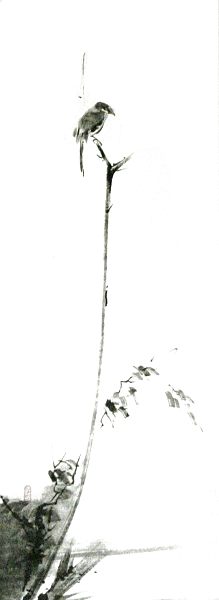| architecture |
| calligraphy |
| ceramics |
| clothing |
| comics |
| gardens |
| lacquerwork |
| literature |
| movies |
| music |
| painting |
| poetry |
| sculpture |
| tea ceremony |
| television |
| theatre |
| weaponry |
| thematic routes |
| timeline |
| the site |

|
a shrike |
context: painting > Zen painting > Artists
Miyamoto Musashi aka Niten 1584-1645
So for the artists I'd noted for inclusion here, I started to image-google to look at more of their work. I was a bit irritated when trying for this one, as the results were cluttered up with battleships and especially samurai movies. I waded through them for images to do with the artist, and read the accompanying text, and it eventually became clear that actually he was a samurai. A noted one. Hang on, a famous one...
Turns out he is regarded as maybe Japan's greatest ever samurai warrior, a legendary figure. That the movie stills were there because there have been, at last count, nearly fifty films based on him, three starring the mighty Toshiro Mifune, the first of which won an Oscar - and loads of books, and comics and TV series and so on. That the second biggest battleship Japan ever built bore his name. That he wrote one of the most famous books on swordfighting ever. That he laid out towns, including Himeji around the famed White Heron castle. That he was undefeated in over 60 duels, including some astounding victories.
Fantastic Fighting Stories of Musashi
It's easy to find vast amounts of material on that part of his life, but there is much less on him as an artist. This may be partly because he's an odd one out - I believe he was the only artist I listed under the Zen heading who had no formal Zen connection, who wasn't a monk or priest. He did often paint the great Zen subjects, particularly Hotei and Daruma, and his work does look highly Zen, and there is plenty of Zen in his writings, but there are hints of other flavours of Buddhism, particularly Shingen, too. Whatever, it looks Zen to me, so it goes in this section.
He became an artist late in life, using the art-name Niten, after settling down following decades of wandering and duelling. I think the shrike shown here is a beautifully designed and balanced image, with superb tonal control and real force. I am wondering now if the intensity, the pre-strike watchfulness and poise, is projection on my part, but I fell for his work because of this painting more than any other, and that was before I knew he was a samurai of any kind.
